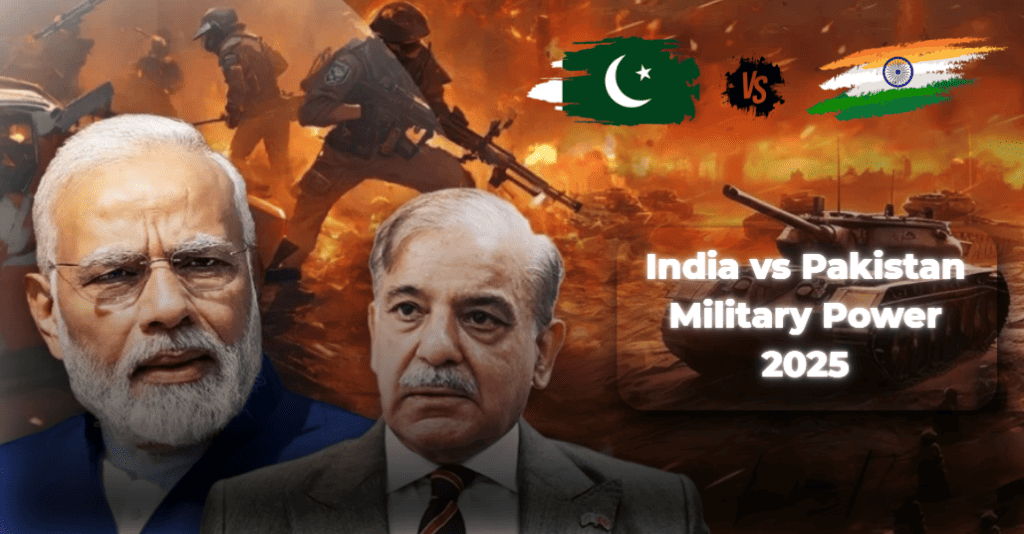

The geopolitical rivalry between India and Pakistan continues to draw international attention, especially in the realm of military strength and defense preparedness. As of 2025, both nations maintain robust armed forces, but the India vs Pakistan military comparison 2025 reveals a significant gap in terms of weapons capability, defense budget, and technological advancements.
In this detailed comparison, we’ll examine their nuclear capabilities, missile systems, air force strength, naval power, and indigenous production, providing a holistic view of the India Pakistan defense power balance.
Defense Budgets and Spending Power
A nation’s defense capabilities often begin with its budget. In 2025, India’s defense budget stands at an estimated $82.6 billion, making it the fourth-largest military spender globally. In contrast, Pakistan’s defense budget is significantly lower, at around $10.3 billion.
This massive financial gap allows India to invest heavily in:
- Advanced weapons systems
- Indigenous defense projects
- High-end technologies like artificial intelligence and space-based surveillance
Meanwhile, Pakistan focuses its budget on maintaining a credible deterrence and sustaining its conventional forces. This imbalance in spending influences nearly every aspect of the India vs Pakistan army comparison.
Nuclear Weapons and Doctrines
Both countries are nuclear-armed, but their approaches are markedly different.
- India maintains a “No First Use” (NFU) policy, backed by a diversified nuclear triad—capable of launching nuclear strikes via land-based missiles, aircraft, and nuclear submarines.
- Pakistan, with an estimated 170 nuclear warheads, follows a “First Use” doctrine, keeping its arsenal on alert as a deterrent against a potential Indian conventional assault.
While Pakistan may have a slight numerical edge in nuclear warheads, India’s delivery systems are far more technologically advanced and survivable, particularly due to nuclear submarines like the INS Arihant.
Ballistic and Cruise Missile Technology
The missile technology gap between India and Pakistan continues to widen:
India:
- Agni missile series: Ranges up to 5,000+ km
- BrahMos missile: A supersonic cruise missile, co-developed with Russia
- Nirbhay missile: A subsonic cruise missile with long-range precision
Pakistan:
- Shaheen series: Includes Shaheen-III with a max range of ~2,750 km
- Babur cruise missile: Land and sea-based
- Ra’ad air-launched missile: Enhances aerial strike capabilities
When comparing BrahMos vs Babur missile, the BrahMos is faster, more accurate, and operational on land, air, and sea platforms, giving India a tactical edge.
Air Force Capabilities: IAF vs PAF
In air power, the Indian Air Force (IAF) is one of the most formidable in Asia.
- Over 2,200 aircraft including:
- Rafale jets (4.5 gen)
- Su-30MKI
- HAL Tejas (indigenous light combat aircraft)
- Advanced AEW&C systems like Phalcon and Netra
Meanwhile, the Pakistan Air Force (PAF) maintains around 900 aircraft, including:
- JF-17 Thunder (co-developed with China)
- F-16 Fighting Falcons
- Saab Erieye AEW&C
In an Indian Air Force vs Pakistan Air Force match-up, India maintains superiority through:
- Higher quantity and quality of aircraft
- Better radar and surveillance systems
- Indigenous production and upgrades
Naval Strength and Maritime Reach
The India vs Pakistan navy strength comparison strongly favors India.
Indian Navy:
- 2 Aircraft Carriers: INS Vikramaditya and INS Vikrant
- 16+ Submarines: Including nuclear-powered types
- Modern destroyers and frigates
- Blue-water capabilities for global deployment
Pakistan Navy:
- 9 Submarines: All diesel-electric
- Coastal defense-focused
- No aircraft carriers or nuclear submarines
India’s navy is strategically equipped to project power across the Indian Ocean Region, making it a regional maritime superpower. Pakistan’s naval ambitions are growing but still largely defensive and coastal in nature.
Indigenous Military Production
A major difference lies in defense self-reliance.
India:
- Strong domestic defense sector led by DRDO and HAL
- Development of Tejas, Arjun tanks, Astra missiles, and more
- Push for ‘Atmanirbhar Bharat’ in defense manufacturing
Pakistan:
- Relies heavily on Chinese imports
- Some co-production, like JF-17 Thunder
- Limited indigenous systems and research
The strength of Indian defense technology lies in its long-term investment in R&D, allowing for reduced dependence on foreign suppliers and greater export potential.
Strategic Alliances and Global Defense Ties
India:
- Strong defense ties with the US, France, Russia, Israel
- Member of QUAD alliance (with US, Japan, Australia)
- Joint military exercises like Malabar, Yudh Abhyas
Pakistan:
- Strategic partnership with China
- Defense cooperation with Turkey and Gulf countries
- Increasing reliance on Beijing’s military ecosystem
India’s global reach and alignment with Western powers provide diplomatic and strategic leverage. Pakistan’s ties, while effective regionally, are more limited in global scope.
Final Verdict: India or Pakistan – Who is More Powerful in 2025?
While Pakistan maintains a credible military and nuclear deterrence, the overall balance of power strongly favors India in 2025. With a higher defense budget, more advanced missile systems, a blue-water navy, and superior air power, India positions itself not just as a regional power but also as a global military player.
However, both nations must prioritize peace, diplomacy, and stability, especially considering their nuclear capabilities. Military strength must be matched by strategic maturity and diplomatic engagement to ensure the safety of over 1.5 billion people in the subcontinent.
Frequently Asked Questions (FAQs)
Q1: Who has more nuclear weapons, India or Pakistan?
A: Pakistan has a slightly higher number of nuclear warheads (~170) compared to India (~164), but India has more sophisticated delivery systems and a nuclear triad.
Q2: Is the Indian Navy stronger than the Pakistani Navy?
A: Yes. India has aircraft carriers, nuclear submarines, and a blue-water navy. Pakistan’s navy is smaller and focuses on coastal defense.
Q3: Which country has the better air force?
A: The Indian Air Force is significantly stronger in terms of both aircraft quantity and technological superiority

Be the first to comment